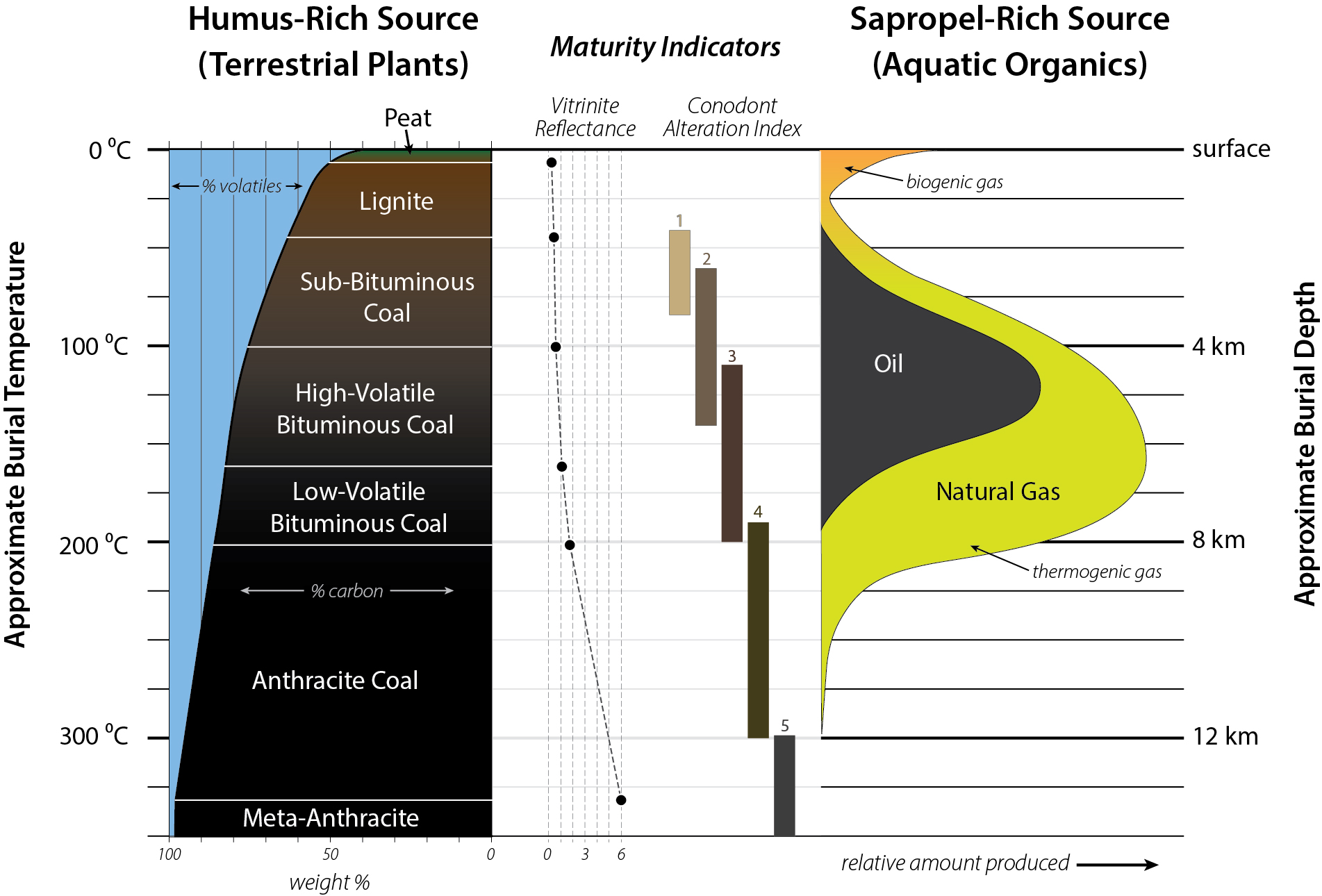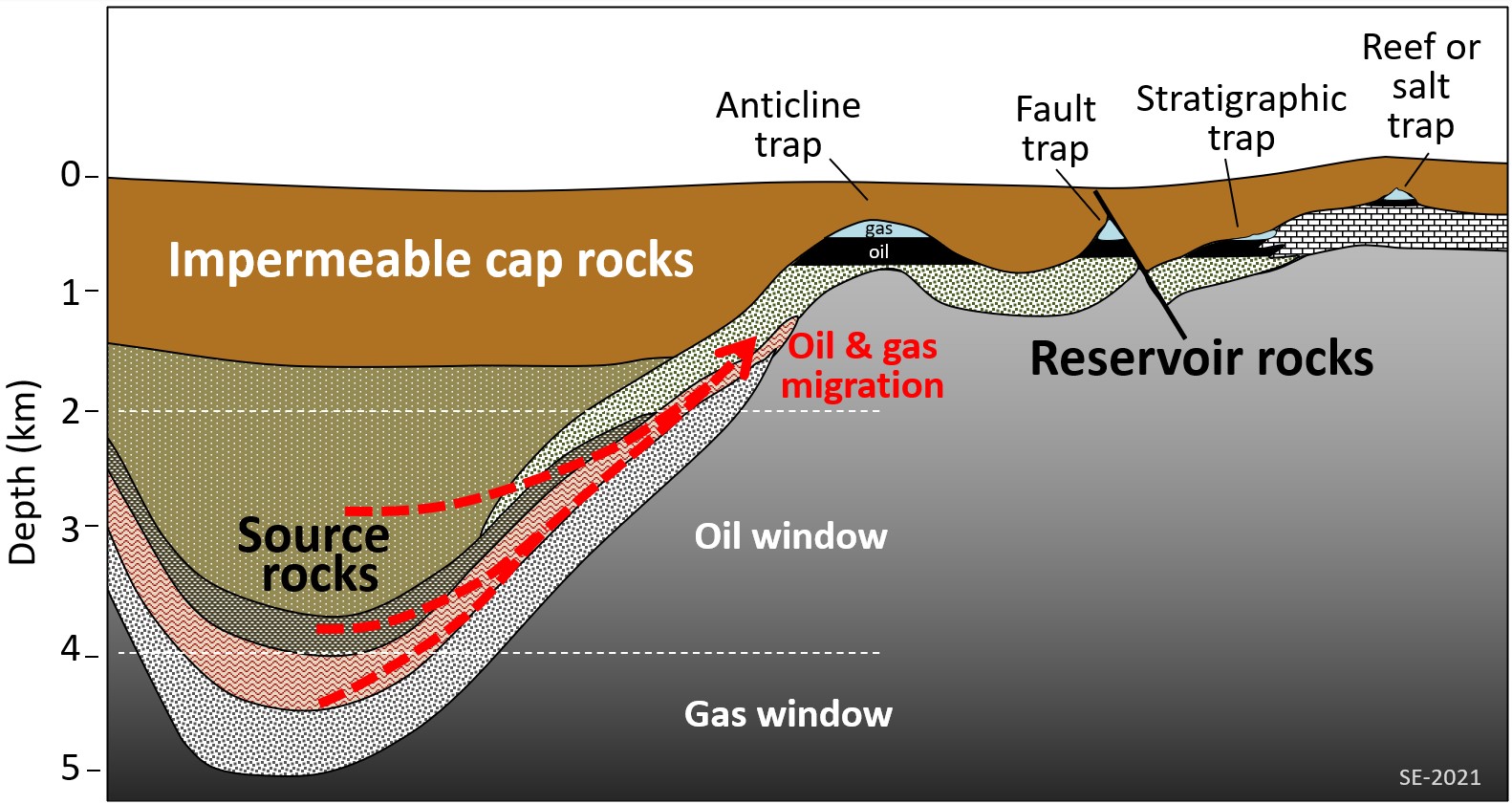7.3: Organic-Rich Sedimentary Rocks
- Page ID
- 26666
Organic-rich rocks (we can arbitrarily define them as having >5% organics) have 3 main components:
1. Clastic particles - sand, silt, clay and other types of material that were transported by wind or water.
2. Humus – dark fibrous plant material found in terrestrial settings.
3. Sapropel – jellylike ooze of plant remains (usually algae) peutrifying in an anaerobic environment
Petroleum-bearing rocks
Significant accumulations of oil and natural gas only happen when all of the components, conditions, and processes of a "petroleum system" are in place.
Petroleum is derived from a sapropel-rich source rock that typically formed in aquatic environments where the remains of algae and plankton were able to escape decay through burial in oxygen-poor settings. As sediment continues to accumulate, the organic material is eventually transformed into kerogen, which is a waxy, insoluable organic residue. Given the microscopic nature of kerogen, geochemical analysis is necessary to know what the source was and to predict how gas or oil prone the kerogen is. The three types of kerogen include:
- Type 1 - made mostly of algal remains; likely to produce oil
- Type 2 - a mixture of terrestrial and marine organics; may produce oil
- Type 3 - mixture of woody and algal material; likely to produce natural gas
As pressures and temperatures increase with burial, the kerogen is eventually converted to oil and/or natural gas. Peak oil generation (the "oil window") typically occurs between 75 and 150 ⁰C and peak gas production occurs at temperatures between 125 and 200 ⁰C.
Accumulation of significant volumes of oil and/or natural gas require numerous other conditions to be met. In the case of a conventional petroleum system, the hydrocarbons must migrate into a reservoir rock that is capped by a seal rock that forms part of a structural or stratigraphic trap. Unconventional systems occur where the hydrocarbons cannot be recovered through traditional vertical drilling techniques; they include tar sands, biodegraded heavy oil, tight reservoirs that have to be horizontally drilled and hydraulically fractured, and others.
text
Figure \(\PageIndex{1}\): Diagram showing the approximate relationship between hydrocarbon generations, source rock type, burial depth and temperature for an area with a geothermal gradient of 25 ⁰C/km. These systems are complex and time dependent; all values and relationships are rough approximations (Michael C. Rygel via Wikimedia Commons; CC BY SA 4.0).

Figure \(\PageIndex{2}\): Elements of a conventional petroleum system include a source, seal (cap rock), reservoir and trap. Note that this area has a higher geothermal gradient than the previous figure causing the oil and gas windows to occur at shallower depths (Steven Earle in 20.3 Fossil Fuels; CC BY 4.0).

Figure \(\PageIndex{3}\): Examples and outcrops of petroleum systems and petroleum-bearing rocks. A) Although many reservoirs have adequate pressure to drive liquid petreoluem to the surface through the well bore, pumpjacks can be used to mechanically lift oil in systems that lack adequate pressure (Antandrus at English Wikipedia via Wikimedia Commons; CC BY-SA 3.0). B) When liquid petroleum reaches or approaches the surface via seeps or erosion of exposed reservoirs, the light component of the crude oil evaporates away and biodegradation occurs leaving behind viscous pitch/tar/liquid asphalt. Perhaps the best known example in North America is the La Brea Tarpits, the famous fossil locality near Los Angeles (Buchanan-Hermit via Wikimeda Commons; CC BY). D) Biodegraded "heavy oil" can also occur in tar sands where buidegradaed oil occurs in the pore spaces of poorly lithified sediment (Michael C. Rygel via Wikimedia Commons; CC BY SA 3.0).
Coal-bearing rocks
The organic material that forms most coal comes from humus (terrestrial plant material) which, under swampy reducing conditions can be preserved as peat. By definition, coal has to be at least 50% weight percent organic material. Economic coal deposits occur in discrete seams (beds) but small fragments of plants can be coalified and preserved within other sedimentary rocks. Although we think of coal as a massive and homogeneous material, many coal seams contain layers of impurities (which turn into ash when burned) and a variety of different types of plant material (macerals) that can be identified with microscopic analysis and sometimes in hand sample.
In certain swampy, clastic-poor environments significant accumulations of plant material can escape decay and accumulate to form relatively thick layers of peat. With increased burial and compaction, volatiles (water and gasses) are driven out and the percentage of carbon increases and the peat can progressively transitions to lignite, bituminous coal, and eventually anthracite coal.
Given its composition, coal occurs only in Devonian or younger rocks; the majority of it accumulated in the Late Paleozoic when vast areas of continental crust were subsiding in response to mountain building and within the humid tropics.

Figure \(\PageIndex{4}\): Outcrops of coal. A) We commonly think of coal as a homogenous black rock, but it often contains bright bands, dull bands, fossils and other identifiable original components, and clastic splits (Michael C. Rygel via Wikimedia Commons; CC BY-SA 4.0). B) Outcrop of the Foord Seam in a strip mine in Nova Scotia that intersected older underground workings (Michael C. Rygel via Wikimedia Commons; CC BY SA 3.0).
Additional Readings and Resources
- Petroleum System on the AAPG Wiki: https://wiki.aapg.org/Petroleum_system
- Kentucky Geologic Survey's webpage on coal: https://www.uky.edu/KGS/coal/

